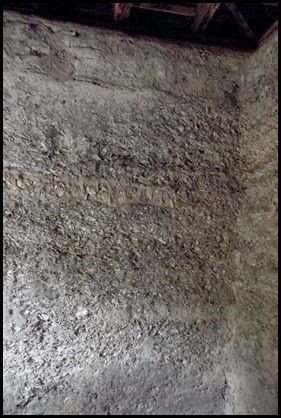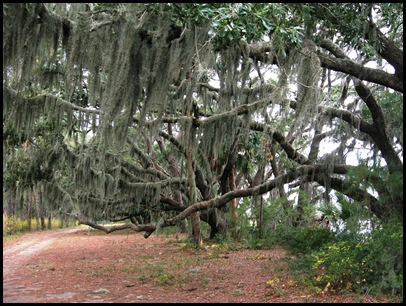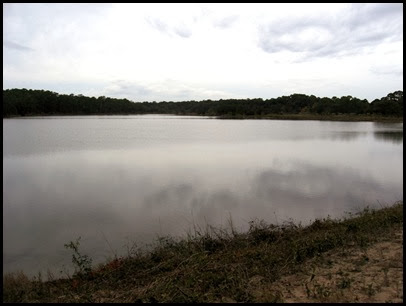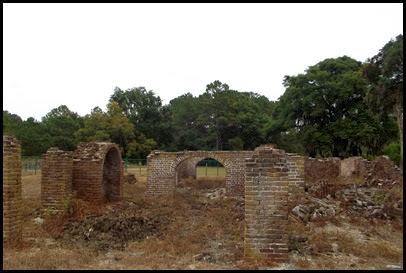Friday November 15, 2013
Edisto Island State Park, South Carolina
I’m surprised no one but Gypsy commented about the name of this preserve.
I thought the same thing she did, that the only time I’d ever heard that name was in relationship to Australia. And for all I know the man who renamed it might have been Australian.
The early history of Botany Bay can be traced back to two pre-civil war plantations, Bleak Hall Plantation and Sea Cloud Plantation. Both were located on the Ocella Creek, a branch of the North Edisto River, where we paddled yesterday. Bleak Hall was originally developed by the Townsend family in the early 1800’s. It is said that he was an admirer of Charles Dickens and named the property after the novel Bleak House. Not sure I’d name a plantation in such a gorgeous area bleak anything. But I suppose the giant live oaks draped in spanish moss could be seen as bleak by some. By the mid 1800’s, owner John Townsend purchased the adjoining Sea Cloud Plantation and was producing more cotton than any other plantation in South Carolina.
About a year after South Carolina succeeded from the Union, Edisto island was evacuated and subsequently occupied by the Union army. The Civil War was devastating to the island and its plantations. Townsend and his descendents worked hard to revive the plantation and continued producing the Sea Island Cotton for which he was famous until the 1920’s when the boll weevil pretty much destroyed the cotton industry in South Carolina.
The plantations remained in the Townsend family until the 1930’s when Dr. James Greenway combined them and renamed them Botany Bay. I wonder if his ancestors were from Australia. Botany Bay was acquired in 1973 by John Meyer who deeded the property to the state , but only after the death of his wife Margaret. Lucky for us, but I wonder how his heirs felt about it.
Of course this five mile ride takes us most of the day.
The drive through the preserve is just over 3 miles long but if you bike it and bike down to the beach it becomes a 5 mile ride. At the entry kiosk they give you a hang tag and a map with explanations of 15 numbered points along the way. You can stop anywhere you like.
The roads are sand and for the most part hard packed so we had no trouble with our hybrid treks. I hope you can click the map and enlarge it to see the road and the numbered spots more clearly.
We drive down the long road from point one the kiosk to point 3 which is on the Bleak Hall Plantation grounds. We are told to park the car here for the bike ride. All that is left of the plantation is the ice house and a tabby gardener’s building both built in the 1800’s. Beneath the floor boards of the ice house is a storage pit for ice cut in New England and brought down on tall ships where it was insulated in saw dust. I guess in the hot Low Country summers all the owners wanted cool drinks. Really beautiful building for an ice house, looks like a chapel to me. It opens on the end. The sides are just decorative carving.
The first Bleak Hall mansion overlooked Ocella Creek.
It was two and a half stories high with a cupola on the top used by both Confederate and Union troops as a lookout over the North Edisto River. The original Bleak Hall burned after the Civil War and was replaced by another large house built in Victorian style.
Here is the only drawing of Bleak Hall I could find on the internet. I believe it is the original house and assume it was located somewhere in the vicinity of the ice house. This is the current view of Ocella Creek.
This small tabby structure on the grounds served as a gardener shed for Oqui, a Chinese gardener, who was brought here by Admiral Perry’s expeditions in the 1850’s. Wonder if he came willingly??
Tabby is made from lime, sand and oyster shells. The tradition of tabby construction began in the 1700’s and apparently the greatest number of still existing structures and “Tabby Ruins” is located in nearby Beaufort County South Carolina where we will be going next to stay at Hunting Island State Park.
The gardener’s shed tabby construction is covered with traditional stucco, a mix of lime, sand and water.
Interior walls
The land has changed a lot since plantation days
The sand roads run along many agricultural fields planted with corn, sunflowers and wheat which provide food for deer, doves, turkeys, fox squirrels and songbirds.
This beautiful spot along the creek was apparently once the site of the homes of plantation slaves.
No trace of the structures remains. I wonder if these giant live oaks once sheltered these people over 150 years ago and could tell their stories.
The South Carolina DNR has made a number of changes to Botany Bay including adding Jake’s Lake in the 1970’s.
We bike over the dike with the lake on our left and the marshes on our right. It is near low tide but we don’t see as many waterfowl as I would imagine we might if we weren’t here during hunting season on the preserve which is closed for that purpose Saturday through Tuesdays during most of November.
On the other side of the dike we are now on Sea Cloud Plantation land.
It is from the Sea Cloud landing that we launched our kayaks onto Ocella Creek yesterday to paddle the marshes. If you haven’t read that post, you can find it here.
Further down the lane are ruins of the Sea Cloud plantation built by Ephraim Seabrook in 1825. There was no explanation on the site about what happened to the plantation.
The size of many of the live oaks along the road is amazing. You know how we love big trees. I sure wish they could talk and tell me more about this history of this place than the information provided does.
We cross over the upper dike of Jason’s lake.
Sea Cloud fields are planted with Egyptian wheat , sesame, millet, and corn. Portions of the fields are left fallow to grow native vegetation.
We pedal into the last stretch of road before returning to the car.
Here we take the turn off to the beach area of Botany Bay. There is a parking lot about half way to the water. People can come in for the day to enjoy miles of unspoiled Atlantic Ocean beach which today is nearly totally deserted. You can bike to the parking lot and on down nearly to the ocean front itself.
Botany Bay rules prohibit removal of anything including seashells from the property. Thus you can see a lot of shells here for everyone to enjoy.
Even in death the trees are big and beautiful. The lowest limb above my head is 5’ off the ground.
The forager is up to no good.
Right next to where the car is parked is a giant pecan tree and the ground under it is littered with pounds of pecans. What about that prohibition?
So where is that Bache??
Also right by the car is a sign for our last stop, Indian Point, which was a community for the Cusabo Indians (Edisto Indians) who inhabited this area dating back to 2500 B.C. Devastated by disease and increased European presence, they disappeared in 1728. Indian Point is also the home of the Bache Monument survey line end point. The mate to the one we saw at the Education Center. We’re pretty excited to see this area.
We follow this sign and another like it and end up at a fork in a grassy path with no indication where to go. We take both forks one after the other and can find nothing but too many mosquitoes biting on this November day. What a bummer. Really wanted to have a pair of Bache bookends.
We’ve spent a beautiful day here in Botany Bay and I highly recommend it as a place to visit when in this area but I would be remiss if I did not mention things I found while doing some research on the Plantations. Not much information was provided about them on site and I didn’t find much on the internet either. But I did come across a very disturbing article by an internationally recognized and honored artist regarding the cruelty of these plantations to their slaves.
This gave us both some food for thought.
She claims this is well known locally and by national historians but is glossed over in preference to the graceful southern plantation picture promoted for tourism throughout the South. If these particular plantations were both as infamous as she suggests, it might explain why a later owner in combining them changed the name to Botany Bay and had the Sea Cloud Plantation house taken down to its foundation.
I include this link not to recommend her article as truth but only for your information if you are interested. I also found some very powerful words by Mr. Townsend, owner of Bleak Hall, in an 1860 speech he gave to The Edisto Island Vigilant Association. warning of the losses abolitionists will cause southern plantation owners and condemning the “Black Republicans” and their presidential candidate Mr. Lincoln.
When I return to Bleak Hall, and I certainly will, it will be with more questions than answers and with a sense of reverence for what well may have happened here to the ancestors of people of the local Gullah Community.



































Love the picture of you standing by the dead tree.
ReplyDeleteThe live oaks are magnificent! Just gorgeous.
ReplyDeleteBotany Bay is in New South Wales near Sydney, and was originally set up by the English as a penal colony. A lot of Irish were sent there for very little reason except they were Irish.
I am currently reading a slave narrative I picked up when we were in Colonial Williamsburg. It was originally published in 1861 and describes in detail the authors life and experience in slavery - a first hand account. I must admit it was a little creepy for me to be tramping around on two slave plantations where the atrocities of slavery were actually perpetrated. SC seems to want to erase and forget that part of the story. I understand why, but I think it is wrong to forget and try to pretend it did not happen or that it does not matter any more. Otherwise, the natural beauty here is incredible, and I did enjoy that.
ReplyDeleteLove that sand dollar!!! Totally different from the ones here on the Oregon Coast.... isn't nature wonderful!
ReplyDeleteThe link was profound and disturbing, as I am sure you knew it would be. You and I have been to places in the west that carry a sad history, but I never ever imagined my beautiful Edisto like this. I had no clue about bottle trees, either. I loved learning about Gullah culture when I was there, but never thought that visiting a plantation might be something other than a beautiful garden or lovely architecture. Funny how we can all be so dang superficial and not notice what my be beneath it all. sheesh, Sherry....your post was beautiful, I thank you for the link, but it certainly was NOT happy reading!
ReplyDeleteI often feel haunted when we visit plantations thinking about what atrocities might have occurred there. Charleston is beautiful but thinking of the infamous slave auctions casts the city in a darker light for me.
ReplyDeleteFascinating history and gorgeous photos of the trees. I especially like the dead tree photo.
When I think Botany Bay, I think of Disney, or Sea World...it seems one of them also have a Botany Bay.
ReplyDeleteIt looks like a beautiful and interesting place, despite it's sad history.
Thank you for posting this, Sherry. I have naturalist friends who love to tramp around Botany Bay. I would bet most of them do not know the sad history.
ReplyDeleteIt saddens me that of all the weeks I've spent in houses on Edisto, I've never been to Botany Bay. Just shows how my life has changed since those days of one week Spring Break beach visits where the focus was on getting by with as little activity as possible! After seeing this through your eyes, Bill and I can't wait to return. With the SC beaches being closest to us, we were aware (and often bothered) by the blatant way in which slavery issues are covered up by the tourism depts. It's also pretty evident in GA, but for some reason, seems not so much as SC. As David said in his comment, it's ugly, but it's part of our history and disrespectful to the ancestors of those folks (horrible as their lives were) if we try to cover it up to make things "pretty." LOVED the picture of the Sand Dollar!
ReplyDeleteSo many places have hidden histories. Tourism wants to make their place look good. Interesting that the truth gets squashed even when we know people notice and take interest in stories of human suffering. How very sad. Not a history to be proud of and so SC apparently hides it. A shame. That tree looks like a dancer. Stretchng her shadowy limbs. Pretty place. Very informative blog! Another one well done :)
ReplyDeleteMost of the plantations we've visited gloss over their slave history, while it is an unfortunate part of our history it should be talked about in conjunction with the history of the home. Another place to add to our growing list of places to see on the east coast, thanks for sharing. You might find the Old Sheldon Church near Yemassee SC interesting when you are at Hunting Island, not a lot there but if you are passing by it's worth a stop and it's free.
ReplyDeleteLove, love, love the size of those trees.
ReplyDeleteIt is unfortunate that much of our history is distorted.
Love the trees! That ice house is really cool- love the little gable and the architectural details. I also thought it was a church. Looks like you had a nice bike ride. Keep on having fun!
ReplyDeletexxxooo
I have to agree with Sue. Your link was not easy reading, but made me think... particularly her equating Southern plantations to German concentration camps. Plantations make me feel about as uncomfortable as I feel on Indian reservations.
ReplyDeleteVery disturbing link....the bottle tree I found creepy ...as I have
ReplyDeleteseen these bottle trees in landscaping in the here and now..'
love your tree pics
Sherry, I love the way you find the history of areas you visit, both good and bad. I've seen first hand the horrors and cruelty mankind can do, but these truths should not be hidden. We need to learn from the mistakes of the past.
ReplyDeleteThank goodness that nature can cover mankind's cruelty with peace and beauty. Very thoughtful post.
PS: I thought the name of Botany Bay was borrowed from a clothing line sold at JC Penny stores... ;c)
ReplyDeleteYou are a terrific tour guide. You should park beside us and show us Florida :)
ReplyDeleteLove those cypress tress…. just love 'em. Whenever I see huge big ol trees … I wonder who sat under them and well? trees and their space are just beautiful things.
ReplyDeleteHow interesting about the shells! love seeing them where they wash up. That is rare… so many love to collect them.
oh, lord? David in jail for pecan pilfering? hope no one had a cell phone about to take a picture!
I don't want to hear any more about the slave horrors… I have enough that flashes across my monkey mind at night as it is… unbelievable
I know Botany Bay is in Australia. However, I must confess my first thought is of Star Trek. The SS Botany Bay is the ship that was commanded by Khan. Looks like a beautiful place to visit with some very interesting history.
ReplyDelete